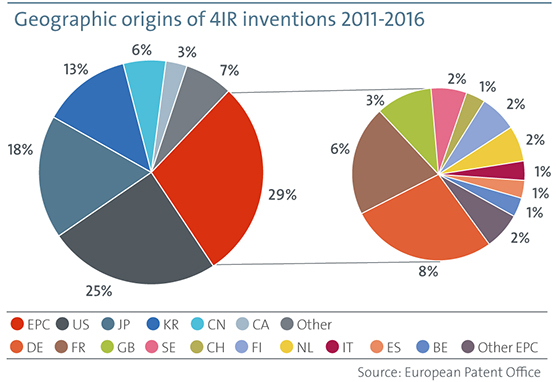According to a new study Patents and the Fourth Industrial Revolution (4IR), conducted by the EPO the number of filed patent applications that relate to IoT, i.e. smart connected objects, are increasing rapidly.
Over the last three years the increase amounts to 54%. Together with Handelsblatt Research Institute, the EPO has identified almost 50 000 applications in the IoT field, which have been filed until the end of 2016.
Three relevant technology sectors have been identified; the core technologies in the Information and Communications Technology (ICT) field. These make it possible to create connected objects. Then there are the enabling technologies that complement core technologies, e.g. Artificial intelligence (AI) and user interfaces. The third sector is where the technologies are applied, i.e. for instance in vehicles and homes.
The study also reveals that during 2016 more than 5000 patent applications relating to autonomous objects, such as self-driving cars, were filed.
Listed among the 25 top applicants within the 4IR technologies are companies such as Samsung, LG, Sony, GE, Google, Apple and Toyota. This means that the patent applications originate from different parts of the world, where the Asian countries are clearly dominating with 37% of the applications originating from either Japan, South Korea or China, while 29% originate from European countries, and 25% from the US. In Europe the majority of applicants is based in Germany, France or Great Britain, but as clear evidence of the Swedish IoT revolution shows, Sweden positions itself in an honourable 4th place. The share of domestic inventions is for example 57% for Ericsson.
One interesting conclusion that can also be drawn from the study is that the application domain “Personal”, i.e. inventions relating to healthcare, is one of the fastest growing sectors of 4IR. Digital technologies can be used to improve health quality by providing smart healthcare solutions. Smart health elements can be used in various medical fields, such as real-time monitoring; using sensors and mobile devices and AI, or telemedicine; facilitating interactive remote contact and monitoring between medical staff and patients. Smart health care also entails block chain technology as a basis for comprehensive electronic health record, as well as computer aided surgery, which for instance can be image guided or robot-based surgery.
Smart wearables focusing on preventive measures are also a part of smart health, where collection of data from a user, e.g. related to physical movement or hearth rate, can be used to improve fitness and reduce risk of stress related symptoms. Examples of Swedish companies in this field are Lifee; who have created a wearable device for children to monitor and encourage physical activity and Linkura; a company that focuses on detecting individuals prone to negative stress.
For more information, please visit EPO’s website.





